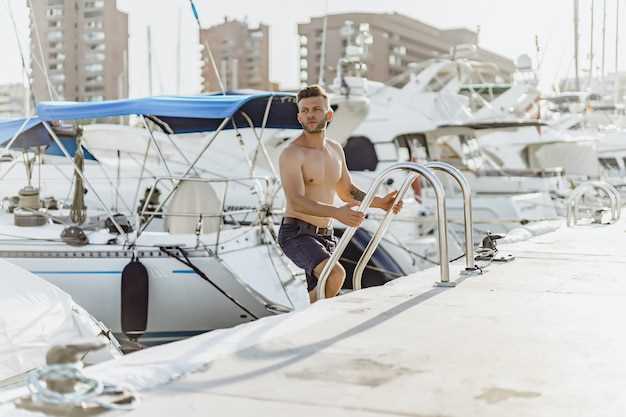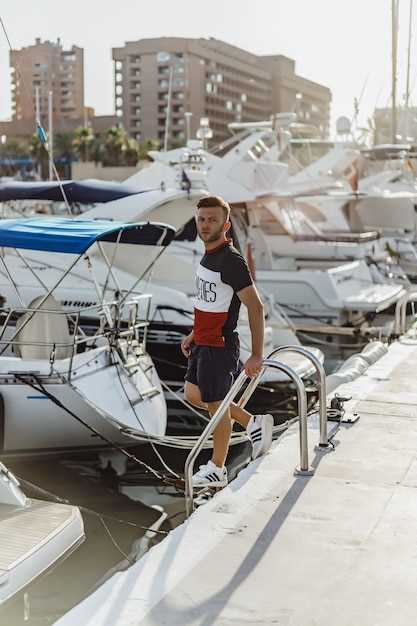Recommendation: Inspect the propulsion data and speed performance first, then confirm headroom and crew safety across the main decks to set expectations for spa days and long passages.
From the quay, the 55m Quinta Essentia presents a panoramic profile, with a bridge that is positioned for maximum visibility and crew efficiency. michela from the in-house design team highlights how the exterior lines streamline hydrodynamics, ensuring the yacht rides smoothly even when the dockside wind picks up without sacrificing interior access to the tender garage.
Inside, the layout offers custom spaces and facilities that serve both private guests and charter crews. The spa area includes a sauna, a dedicated gym, and shaded lounging with panoramic windows. The climate system uses advanced conditioning to maintain comfortable temperatures across salons and decks without excess energy draw.
In the owner’s sector, the wardrobe and private lounge are custom and positioned for easy access to the captain’s bridge. The shipyards supplied the structural upgrades for reliability, while an additional water-system loop adds redundancy in adverse weather. The acquisition trajectory and berth plan are outlined in the official page, and the team emphasizes an entirely integrated approach from hull to deck.
For potential operators, Quinta Essentia delivers clear data: high-performance speed targets, robust motors, and a page-level summary that supports decision making. The acquisition of the vessel through reputable shipyards was guided by michela and the team to ensure the facilities meet modern charter standards without compromise.
55m Quinta Essentia: The Lürssen Flagship Overview
first, choose Quinta Essentia for a flagship that blends imposing presence with meticulous build quality. The 55m model rides on an aluminum hull and lightweight superstructure, delivering steady seakeeping and efficient performance through long passages, with interior temperatures regulated around 22–24 degrees.
Includes six cabins and a full-beam master suite, with a spa-style bathroom and guest areas arranged for privacy and social comfort.
anchor handling remains clean thanks to a dedicated service zone onboard; a rescue tender sits in protected storage, ready for emergencies.
interiors by reverberi feel warm and restrained, using natural finishes and tuned acoustics. the model balances formal dining areas with relaxed lounges, so guests can flow through spaces from stern to fore.
steam rooms and a gym elevate onboard wellness; the listing notes this yacht includes a full equipment package. please check the price with the broker for a detailed breakdown.
north european credentials suit the project, with service networks in france and dutch ports ready for regattas or private voyages.
does Quinta Essentia meet the expectations of superyachts buyers? yes, it feels prepared for serious charter or private ownership, and the design also appeals to other yachts.
Hull Form and Seakeeping: Stability, Draft, and Rough-Water Performance
Prioritize a hull form that blends a deep forward entry with a robust midsection to minimize pitch and improve seakeeping in heavy seas. Target a draft around 3.8 m and a beam near 9.4 m to maximise waterplane area while allowing port access; this balance reduces motion energy and increases comfort for your guests, for both stability and interior space. With a displacement near 1,400 tonnes, the weight distribution supports stable trim, enabling a double master suite on the upper deck and a panoramic lounge to be enjoyed even when waves run high. In practice, the process leads to noticeable motion reduction, and you will notice the hull performs better in a broad range of conditions.
VRIPACK’s approach to hull form uses parametric sections to reduce vertical acceleration and improve trim control. The process includes refining waterline shapes to increase waterplane stability while keeping draft within the target. The combination accommodates deck layouts with a panoramic master suite and en-suite facilities, and the design easily accommodate a spa area with a bath and steam room on the lower deck. The wi-fi antennas are mounted to minimise vibration, preserving connectivity in rough weather.
Stability is controlled by stabilisers and ballast management. Two fin stabilisers deliver a noticeable reduction in roll at speeds from 10 to 14 knots across typical wave angles, and owners will notice the smoother motion. Experienced crews confirm this reduces the liability of unnecessary motion and contributes to safer handling in heavy seas. This setup, paired with a low center of gravity and midship weight distribution, increases righting moment and helps the decks stay drier through blast chop.
Rough-water operation benefits from a balanced weight distribution and controlled trim. At 12–14 knots in heavy chop, the hull maintains a comfortable motion profile with reduced peak accelerations, while the stabilisers and propulsion system operate within their designed envelope. The design also increases onboard versatility: the master suite can accommodate guests easily, the en-suite remains private, and the spa area featuring a bath and steam room remains accessible from the decks. This approach increases reliability and reduces the liability of guest discomfort during long passages.
Propulsion Architecture: Hybrid System, Top Speed, and Range

Recommendation: adopt a diesel-electric hybrid propulsion with a parallel layout to maximize efficiency during Adriatic cruising and keep noise low for outdoor entertainment, while preserving electric propulsion for peaceful anchor moments.
Currently, the velema propulsion concept contains twin diesels driving electric motors through a double-redundant, managed system. The artemis energy-management platform coordinates power flow, and the essentias battery pack supports silent operation in staterooms and on deck whilst guests enjoy entertainment in outdoor areas. This setup can be tuned to time transitions smoothly, so the crew can operate together with guests without disruption, even during busy port calls.
- Hybrid architecture and energy storage
- Architecture: parallel diesel-electric with a dedicated shaftline and electric motors that engage automatically or on command.
- Storage: essentias battery bank ≈ 2.2 MWh, with double-redundant controllers to ensure reliability in all sea states.
- Management: artemis platform handles real-time power balancing, regeneration during operations, and seamless mode-switching to accommodate cruising, docking, or quiet evenings.
- Top speed and performance targets
- Top speed: up to 19 knots when full power is required, with efficient hybrid cruising around 12–14 knots.
- Electric-only operation: 8–10 knots for silent running while at anchor or during dockside events.
- Transition time: power blending occurs in fewer than 60 seconds, keeping the ride comfortable for guests and crew alike.
- Range and endurance
- Cruise range: up to 6,000–6,500 nautical miles at about 11 knots on a full fuel and battery cycle.
- High-speed range: roughly 1,200–1,500 nautical miles at 16–18 knots, depending on load and sea state.
- Regeneration: gensets and shoreline charging refresh the bank at ports along the Adriatic, supporting long itineraries without frequent refits.
- Operational considerations for a superyacht fleet
- Crew workload: automation reduces manual trims, freeing time for maintenance and guest interaction.
- Entertainment and lifestyle: ship systems are designed to maintain a consistent ambient level throughout the vessel, from west-facing staterooms to the main deck.
- Deck and anchor operations: shore power and battery reserves ensure smooth maneuvers and quiet maneuvering near crowded anchors.
Disclaimer: performance varies with load, sea state, and stern resistance. For precise numbers and tailored targets, contact the engineering team at the yard. This section contains focal details to help understand how the propulsion system integrates with overall vessel dynamics, while reinforcing the distinctive, entertainment-forward character of the superyacht throughout the Adriatic coast.
Deck Layout and Tender Garage: Aft Beach Club and Platform Access
Recommendation: Deploy a hydraulically controlled platform from the tender garage that unfolds in under 60 seconds and anchors to a water-level float, keeping the aft beach club area clear for lounging and socializing.
The deck layout places the aft beach club at the stern, with teak seating for eight, a compact weather-shielded bar, and retractable cushions. Steps lead down to the platform edge, with gran anti-slip inserts guiding guests from chairs to the water. The beam gives a wide opening for the platform, preventing congestion on the swim deck while leaving room for toys and a second craft if needed. The gross mass of gear is accommodated within the tender garage without compromising crew movement.
Platform access follows a clear, safe sequence: the hatch opens, the winch motors power the platform down, and the edge drops to water level at approximately 12 degrees. A hinged edge provides a smooth transition for guests or rescue craft, and continuous seals prevent direct contact with sea spray. This process keeps the bathrooms on the main deck unaffected and preserves comfort for owners and guests during adriatic charters, whilst the crew maintains control from contact points on the aft bulkhead. It is believed that this arrangement reduces handling time and improves safety during water-access moments.
Construction leans on italian hardware from reverberi, with high-accuracy sensors and inserts that secure the platform when stowed. The reverberi drive units offer quiet, high-torque operation, while the design remains simple to service in stperiod checks. From the vantage of the crew, operation is straightforward, and owners can rely on the platform to deliver water toys, dinghies, or a rescue craft without delaying the beach club experience.
In practice, the after section provides easy water access without compromising safety or comfort: the gymnasium and crew corridor stay separate from guest zones, a dedicated contact point supports the lines for docking or rescue, and the platform interface is designed for rapid use during adriatic excursions. The result is a seamless blend of luxury, safety, and efficiency for the entire crew and guests while enjoying the aft deck and water-edge platforms.
Interior Design and Accommodations: Owner’s Suite, VIP Cabins, and Crew Quarters
Opt for the Owner’s Suite on the main deck as the primary retreat, featuring a generous lounge and a double bed arrangement. Isolate it from the diesel and motor rooms with high-performance mounts to minimize vibrations during long passages. The suite should span about 60-70 sqm, including a dressing area and a spa-like bath, delivering a calm, hotel-like atmosphere with meticulous detail in materials and lighting to keep guests comfortable, as shown on the page.
VIP Cabins: two suites forward of the main deck, each around 25-28 sqm with en-suite heads and generous windows. The design follows a clean architecture vocabulary with a restrained palette. Built as designed, fixtures reflect antonini’s craft, with aeolian textiles and soft lighting in the lounge area to create a serene environment. The accommodations are divided into areas for sleeping, dressing, and relaxation, allowing guests to assume privacy and unwind.
Crew Quarters: situated on the lower aft deck, with four double-berth cabins, each with en-suite head, a compact crew mess, and a dedicated laundry facility. A separate corridor preserves guest privacy. The facility is arranged to support long charters, with service zones clearly delineated by levels and access points. The crew spaces keep noise and vibrations away from guest areas so everyone enjoys peaceful operations. Water tanks hold several thousand gallons for operations, and diesel storage is sized to support motor and generator loads.
Finish and materials: walnut joinery by antonini, stone and marble surfaces, and aeolian-linen textiles combined with soft lighting to create warmth. The interior language aligns with columbus-inspired geometry and the penta layout of the mechanical spaces, ensuring the architecture flows across levels. Images supplied by charterworld illustrate the consistent standard; the source is источник charterworld. Acquisition notes highlight the lineage of the project and the current configuration, underscoring owners’ responsibility to maintain a high level of finish. The boat’s ambience invites guests to enjoy every moment in these suites while the vessel remains at sea.
Amenities and Entertainment Suite: Spa, Gym, Cinema, and Dining Concepts

Install a modular spa suite as the anchor of the entertainment deck, with a thermal zone, a private terrace, and a four-seat hydrotherapy tub that remains usable while the yacht is underway – a Cannes-inspired detail that sets the tone without sacrificing circulation along the corridor. At 12 knts, cruise noise remains low thanks to selective isolation and engine-room damping.
The gym spans 45 m² along the starboard side, featuring a cable station, free weights up to 40 kg, two treadmills, a spin bike, and a functional area with a plyo box. Large windows frame sea views, and a mirror wall boosts motivation; climate and ventilation run independently with an estimated peak draw around 60 kW, backed by diesel gensets to ensure quiet operation at lower RPMs when guests are onboard.
The cinema cabin seats 12 in a tiered arrangement, with a 3.2 m diagonal screen, 7.1 surround sound, blackout shading, and a compact bar for refreshments. Integrated media servers handle an international catalog aligned to owners’ preferences; the space is acoustically treated to preserve tone without echo across voyages at sea.
Dining concepts split into three modes: formal dining for twelve, casual lounge dining for eight to ten, and al fresco deck dining for twelve, all managed with a dedicated galley connection and weather-controlled zones. Menus emphasize earth-to-table sourcing, with partnerships from brands in Cannes and other international producers. A service corridor and master station allow smooth sequence of courses along the deck, reducing wait times and enabling seamless launch of service as guests move between areas.
We assume the design supports questions from owners about layout flexibility; the engineering core isolates each zone with its own controls, ensuring the spaces can operate at reduced energy when not in use. The disclaimer notes that configurations vary by hull, launch edition, and the owners’ master plan; the setup is intended to match the ship’s identity while preserving an entirely cohesive experience for guests from around the world.
| Zone | Area (m²) | Key Features | Power/Resources |
|---|---|---|---|
| Spa | 40 | Thermal zone, private terrace, hydrotherapy tub for 4, steam room, treatment beds | Diesel genset back-up; climate control 8 kW; water loop |
| Gym | 45 | Cardio suite, free weights up to 40 kg, cable station, functional zone | Independent HVAC; ~60 kW peak; fresh-air intake |
| Cinema | 22 | 3.2 m screen, 7.1 sound, tiered seating, bar | Projector, acoustics, media server |
| Dining Concepts | 60 | Formal for 12, casual lounge for 8–10, al fresco for 12 | Galley access, climate zones, earth-to-table menus |

